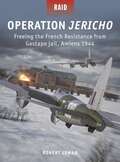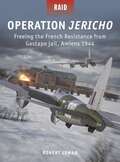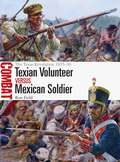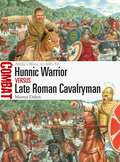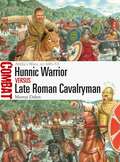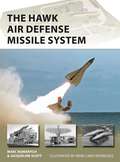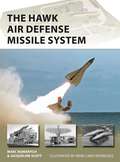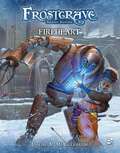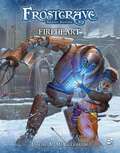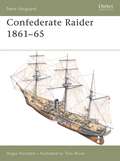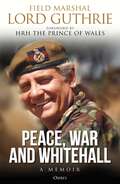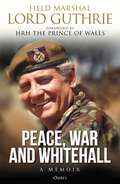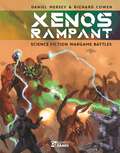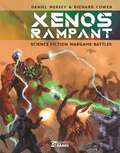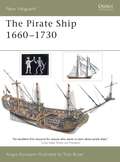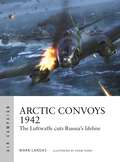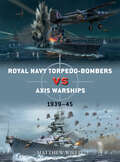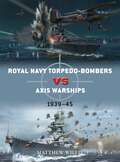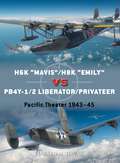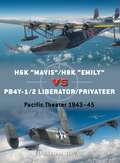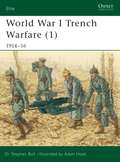- Table View
- List View
Operation Jericho: Freeing the French Resistance from Gestapo jail, Amiens 1944 (Raid)
by Robert LymanThis is the story of Operation Jericho, the spectacular prison break staged by an elite group of British, Australian and New Zealand bomber pilots, who flew a daring low-level mission to blow holes in the walls of Amiens jail and free French Resistance prisoners under the sentence of death during World War II.With D-Day looming, early 1944 was a time of massive intelligence activity across northern France, and many résistants were being captured and imprisoned by the Germans. Among the jails full of French agents was Amiens, where hundreds awaited likely execution for their activities.To repay their debt of honour, MI6 requested an air raid with a seemingly impossible brief: to simultaneously blow holes in the prison walls, free as many men and women as possible while minimizing casualties, and kill German guards in their quarters. The crews would have to fly their bomb-run at an altitude of just 20ft. Despite the huge difficulties, the RAF decided that the low-level specialists of No. 140 Wing had a chance of success. With the aid of first-hand accounts, explanatory 3D diagrams and dramatic original artwork, the eminent historian Robert Lyman explains how one of the most difficult and spectacular air raids of World War II was pulled off, and debunks some of the myths over why the raid was ordered in the first place.
Operation Jericho: Freeing the French Resistance from Gestapo jail, Amiens 1944 (Raid)
by Robert LymanThis is the story of Operation Jericho, the spectacular prison break staged by an elite group of British, Australian and New Zealand bomber pilots, who flew a daring low-level mission to blow holes in the walls of Amiens jail and free French Resistance prisoners under the sentence of death during World War II.With D-Day looming, early 1944 was a time of massive intelligence activity across northern France, and many résistants were being captured and imprisoned by the Germans. Among the jails full of French agents was Amiens, where hundreds awaited likely execution for their activities.To repay their debt of honour, MI6 requested an air raid with a seemingly impossible brief: to simultaneously blow holes in the prison walls, free as many men and women as possible while minimizing casualties, and kill German guards in their quarters. The crews would have to fly their bomb-run at an altitude of just 20ft. Despite the huge difficulties, the RAF decided that the low-level specialists of No. 140 Wing had a chance of success. With the aid of first-hand accounts, explanatory 3D diagrams and dramatic original artwork, the eminent historian Robert Lyman explains how one of the most difficult and spectacular air raids of World War II was pulled off, and debunks some of the myths over why the raid was ordered in the first place.
Texian Volunteer vs Mexican Soldier: The Texas Revolution 1835–36 (Combat #74)
by Ron FieldFully illustrated with specially commissioned artwork and mapping plus carefully chosen archive illustrations, many in color, this lively study investigates the Mexican soldiers and Texian volunteers who fought one another in three key battles during the Texas Revolution.Following unrest throughout Mexico, in 1835 a revolt began in Texas among the Anglophone and Tejano-speaking settlers, known as Texians. Having retreated after their defeat at Bexar in December 1835, Mexican troops were ordered to re-occupy Texas in early 1836. In this volume, US military history expert Ron Field explores in detail three key battles that ensued. From February 23, Mexican forces besieged the Texian forces at the Alamo at San Antonio de Bexar; in the subsequent battle on March 6, almost all of the Texian defenders were killed. On March 19, forces en route to join the main Texian army were surrounded by Mexican troops at Coleto Creek. Following their surrender, about 340 Texian prisoners were shot by Mexican soldiers in what became known as the Goliad Massacre. On April 21, a Texian force launched a surprise attack on a larger Mexican army near the San Jacinto River, the decisive Texian victory that resulted is the third battle to be investigated in this study. Featuring full-color artwork and maps and drawing upon the latest research, this book investigates the fighting men of both sides at the Alamo, Coleto Creek, and the San Jacinto River, casting light on the doctrine, tactics, weaponry, and combat record of the Texian and Mexican combatants who clashed in the first weeks of the emerging Republic of Texas.
Texian Volunteer vs Mexican Soldier: The Texas Revolution 1835–36 (Combat #74)
by Ron FieldFully illustrated with specially commissioned artwork and mapping plus carefully chosen archive illustrations, many in color, this lively study investigates the Mexican soldiers and Texian volunteers who fought one another in three key battles during the Texas Revolution.Following unrest throughout Mexico, in 1835 a revolt began in Texas among the Anglophone and Tejano-speaking settlers, known as Texians. Having retreated after their defeat at Bexar in December 1835, Mexican troops were ordered to re-occupy Texas in early 1836. In this volume, US military history expert Ron Field explores in detail three key battles that ensued. From February 23, Mexican forces besieged the Texian forces at the Alamo at San Antonio de Bexar; in the subsequent battle on March 6, almost all of the Texian defenders were killed. On March 19, forces en route to join the main Texian army were surrounded by Mexican troops at Coleto Creek. Following their surrender, about 340 Texian prisoners were shot by Mexican soldiers in what became known as the Goliad Massacre. On April 21, a Texian force launched a surprise attack on a larger Mexican army near the San Jacinto River, the decisive Texian victory that resulted is the third battle to be investigated in this study. Featuring full-color artwork and maps and drawing upon the latest research, this book investigates the fighting men of both sides at the Alamo, Coleto Creek, and the San Jacinto River, casting light on the doctrine, tactics, weaponry, and combat record of the Texian and Mexican combatants who clashed in the first weeks of the emerging Republic of Texas.
Hunnic Warrior vs Late Roman Cavalryman: Attila's Wars, AD 440–53 (Combat)
by Murray DahmRoman and Hunnic fighting men are assessed and compared in this fully illustrated study of Attila's bid to conquer Europe in the 5th century AD.The Huns burst on to the page of western European history in the 4th century AD. Fighting mostly on horseback, the Huns employed sophisticated tactics that harnessed the formidable power of their bows; they also gained a reputation for their fighting prowess at close quarters. Facing the Huns, the Roman Army fielded a variety of cavalry types, from heavily armed and armoured clibanarii and cataphractii to horse archers and missile cavalry. Many of these troops were recruited from client peoples or cultures, including the Huns themselves. After carving out a polyglot empire in eastern and central Europe, the Huns repeatedly invaded Roman territory, besieging the city of Naissus in 443. With Constantinople itself threatened, the Romans agreed to pay a huge indemnity. In 447, Attila re-entered Roman territory, confronting the Romans at the battle of the Utus in Bulgaria. The Huns besieged Constantinople, but were unable to take the city. In 451, after Hunnic forces invaded the Western Roman Empire, an army led by the Roman general Aetius pursed the invaders, bringing the Huns to battle at the Catalaunian Plains.Featuring specially commissioned artwork and maps, this study examines the origins, fighting methods and reputation of the two sides' cavalry forces, with particular reference to the siege of Naissus, the battle of the Utus and the climactic encounter at the Catalaunian Plains.
Hunnic Warrior vs Late Roman Cavalryman: Attila's Wars, AD 440–53 (Combat)
by Murray DahmRoman and Hunnic fighting men are assessed and compared in this fully illustrated study of Attila's bid to conquer Europe in the 5th century AD.The Huns burst on to the page of western European history in the 4th century AD. Fighting mostly on horseback, the Huns employed sophisticated tactics that harnessed the formidable power of their bows; they also gained a reputation for their fighting prowess at close quarters. Facing the Huns, the Roman Army fielded a variety of cavalry types, from heavily armed and armoured clibanarii and cataphractii to horse archers and missile cavalry. Many of these troops were recruited from client peoples or cultures, including the Huns themselves. After carving out a polyglot empire in eastern and central Europe, the Huns repeatedly invaded Roman territory, besieging the city of Naissus in 443. With Constantinople itself threatened, the Romans agreed to pay a huge indemnity. In 447, Attila re-entered Roman territory, confronting the Romans at the battle of the Utus in Bulgaria. The Huns besieged Constantinople, but were unable to take the city. In 451, after Hunnic forces invaded the Western Roman Empire, an army led by the Roman general Aetius pursed the invaders, bringing the Huns to battle at the Catalaunian Plains.Featuring specially commissioned artwork and maps, this study examines the origins, fighting methods and reputation of the two sides' cavalry forces, with particular reference to the siege of Naissus, the battle of the Utus and the climactic encounter at the Catalaunian Plains.
The HAWK Air Defense Missile System (New Vanguard)
by Marc Romanych Jacqueline ScottThis is the first history of the legendary US Army's HAWK missile system, the world's first mobile air-defense missile system, which saw service and combat around the world.Designed to counteract the threat posed by advanced 1950s Soviet-built aircraft, the first HAWK unit became operational in 1959. At its peak, it saw frontline service in the Far East, Panama, Europe, and in the Middle East. Units were also used during the Cuban Missile Crisis, Vietnam War, and Persian Gulf War. In the hands of other nations, HAWK proved its efficacy in combat during the Arab-Israeli Wars, Iran-Iraq War, Chadian-Libyan War, and the Iraqi invasion of Kuwait. Credited with shooting down more than 100 aircraft during its combat career, the HAWK system was respected for its lethality. Such was Soviet concern, that it developed electronic jammers, anti-radiation missiles, and other countermeasures specifically to degrade its effectiveness. The US retired its HAWK systems soon after the Cold War ended in 1991 when air defense priorities shifted from aircraft to ballistic missile defense, yet, a modernized version of the system remains in service to this day in many nations. Packed with archive photos and original artwork, this is the first book about the HAWK system. Featuring research from HAWK technical and field manuals, interviews with HAWK veterans, and detailing the authors' personal experiences with HAWK missile units, it provides a comprehensive study of one of the most lethal and effective air missile systems of all time.
The HAWK Air Defense Missile System (New Vanguard)
by Marc Romanych Jacqueline ScottThis is the first history of the legendary US Army's HAWK missile system, the world's first mobile air-defense missile system, which saw service and combat around the world.Designed to counteract the threat posed by advanced 1950s Soviet-built aircraft, the first HAWK unit became operational in 1959. At its peak, it saw frontline service in the Far East, Panama, Europe, and in the Middle East. Units were also used during the Cuban Missile Crisis, Vietnam War, and Persian Gulf War. In the hands of other nations, HAWK proved its efficacy in combat during the Arab-Israeli Wars, Iran-Iraq War, Chadian-Libyan War, and the Iraqi invasion of Kuwait. Credited with shooting down more than 100 aircraft during its combat career, the HAWK system was respected for its lethality. Such was Soviet concern, that it developed electronic jammers, anti-radiation missiles, and other countermeasures specifically to degrade its effectiveness. The US retired its HAWK systems soon after the Cold War ended in 1991 when air defense priorities shifted from aircraft to ballistic missile defense, yet, a modernized version of the system remains in service to this day in many nations. Packed with archive photos and original artwork, this is the first book about the HAWK system. Featuring research from HAWK technical and field manuals, interviews with HAWK veterans, and detailing the authors' personal experiences with HAWK missile units, it provides a comprehensive study of one of the most lethal and effective air missile systems of all time.
Frostgrave: Fireheart (Frostgrave)
by Joseph A. McCulloughThis supplement for Frostgrave provides players with new tools to build, animate, field, and face constructs in their games.In the glory days of Ancient Felstad, artisans competed to produce the most beautiful, the most functional, and the most enduring constructs. These living works of art could be seen everywhere in the city, fulfilling many of the day-to-day tasks that kept the magical metropolis running. They provided transportation and security, worked on construction and cleaning, exterminated vermin, butchered animals, and tended furnaces. Then came the cataclysm. The ice and snow not only buried and destroyed most of the constructs active in the city, but nearly wiped out the knowledge of their creation. Certainly, the constructs animated by the explorers of the Frozen City are crude in both form and function compared to what once existed.This supplement for Frostgrave: Fantasy Wargames in the Frozen City provides a study of constructs, offering expanded rules for their creation, modification, and even re-animation. It examines enchanters' workshops, detailing new magic items and base modifications that aid in the animation process, and also includes a bestiary full of new constructs. Of course, much of the knowledge that was once lost still exists in the frozen ruins, so the book also features several scenarios set in the once-great factories where the art of construct creation reached its pinnacle.
Frostgrave: Fireheart (Frostgrave)
by Joseph A. McCulloughThis supplement for Frostgrave provides players with new tools to build, animate, field, and face constructs in their games.In the glory days of Ancient Felstad, artisans competed to produce the most beautiful, the most functional, and the most enduring constructs. These living works of art could be seen everywhere in the city, fulfilling many of the day-to-day tasks that kept the magical metropolis running. They provided transportation and security, worked on construction and cleaning, exterminated vermin, butchered animals, and tended furnaces. Then came the cataclysm. The ice and snow not only buried and destroyed most of the constructs active in the city, but nearly wiped out the knowledge of their creation. Certainly, the constructs animated by the explorers of the Frozen City are crude in both form and function compared to what once existed.This supplement for Frostgrave: Fantasy Wargames in the Frozen City provides a study of constructs, offering expanded rules for their creation, modification, and even re-animation. It examines enchanters' workshops, detailing new magic items and base modifications that aid in the animation process, and also includes a bestiary full of new constructs. Of course, much of the knowledge that was once lost still exists in the frozen ruins, so the book also features several scenarios set in the once-great factories where the art of construct creation reached its pinnacle.
Confederate Raider 1861–65 (New Vanguard)
by Angus KonstamThe Confederate states adopted radical solutions to counter the naval superiority of their opponents. One of the more successful solutions they adopted was the use of commerce raiders. This book describes the reasons which forced the Confederates to resort to commerce raiding, and outlines the way in which these craft were converted or specially built to perform their role. It details not only the way these craft were operated and manned, but also their brutal attacks, daring escapes and climatic battles against the large numbers of Union warships forced to hunt them down.
Confederate Raider 1861–65 (New Vanguard)
by Angus KonstamThe Confederate states adopted radical solutions to counter the naval superiority of their opponents. One of the more successful solutions they adopted was the use of commerce raiders. This book describes the reasons which forced the Confederates to resort to commerce raiding, and outlines the way in which these craft were converted or specially built to perform their role. It details not only the way these craft were operated and manned, but also their brutal attacks, daring escapes and climatic battles against the large numbers of Union warships forced to hunt them down.
Peace, War and Whitehall: A Memoir
by Charles Guthrie'Charles Guthrie has been one of Britain's foremost soldiers as well as a terrific personality throughout his remarkable life. It is great that he is now telling his own story.' - Sir Max HastingsField Marshal the Lord Guthrie commanded at every level in the British Army from platoon to army group, and was Britain's senior military commander at a time of great change. He oversaw the modernization of the armed forces following the Cold War years and led Britain's military involvement in operations in the Balkans and Sierra Leone. Charles Guthrie was commissioned into the British Army in 1959 at a time when Britain's influence was shrinking throughout the world, and Peace, War and Whitehall describes his operational experience with both the Welsh Guards and 22 SAS in Aden, Malaya, East Africa, Cyprus and Northern Ireland. As a senior officer he commanded the Welsh Guards during an operational tour of the Bandit Country of South Armagh at the height of the Troubles, before leading an armoured brigade in Germany in the midst of the Cold War, and eventually being appointed Commander-in-Chief of the British Army of the Rhine and Northern Army Group as the Cold War ended and the former Yugoslavia began to disintegrate into savage internecine warfare. Peace, War and Whitehall details Lord Guthrie's extraordinary career from a young platoon commander through to Chief of the Defence Staff.
Peace, War and Whitehall: A Memoir
by Charles Guthrie'Charles Guthrie has been one of Britain's foremost soldiers as well as a terrific personality throughout his remarkable life. It is great that he is now telling his own story.' - Sir Max HastingsField Marshal the Lord Guthrie commanded at every level in the British Army from platoon to army group, and was Britain's senior military commander at a time of great change. He oversaw the modernization of the armed forces following the Cold War years and led Britain's military involvement in operations in the Balkans and Sierra Leone. Charles Guthrie was commissioned into the British Army in 1959 at a time when Britain's influence was shrinking throughout the world, and Peace, War and Whitehall describes his operational experience with both the Welsh Guards and 22 SAS in Aden, Malaya, East Africa, Cyprus and Northern Ireland. As a senior officer he commanded the Welsh Guards during an operational tour of the Bandit Country of South Armagh at the height of the Troubles, before leading an armoured brigade in Germany in the midst of the Cold War, and eventually being appointed Commander-in-Chief of the British Army of the Rhine and Northern Army Group as the Cold War ended and the former Yugoslavia began to disintegrate into savage internecine warfare. Peace, War and Whitehall details Lord Guthrie's extraordinary career from a young platoon commander through to Chief of the Defence Staff.
Xenos Rampant: Science Fiction Wargame Battles
by Daniel Mersey Richard CowenScience Fiction wargame rules for large skirmishes, based on the popular Rampant system.Xenos Rampant is a setting agnostic, large skirmish, miniature wargame for fighting science fiction battles using 28mm figures. Developed from the popular Lion Rampant ruleset, the core mechanics featured within will be instantly recognisable to those familiar with the other Rampant systems, while still being accessible to new players. Xenos Rampant contains all the rules, army lists, and scenarios required to fight science fiction battles as well as a whole host of subgenres including: post-apocalyptic, weird war, near future. So, whatever your science fiction preference, the rules can cover it – just let your imagination run rampant.
Xenos Rampant: Science Fiction Wargame Battles
by Daniel Mersey Richard CowenScience Fiction wargame rules for large skirmishes, based on the popular Rampant system.Xenos Rampant is a setting agnostic, large skirmish, miniature wargame for fighting science fiction battles using 28mm figures. Developed from the popular Lion Rampant ruleset, the core mechanics featured within will be instantly recognisable to those familiar with the other Rampant systems, while still being accessible to new players. Xenos Rampant contains all the rules, army lists, and scenarios required to fight science fiction battles as well as a whole host of subgenres including: post-apocalyptic, weird war, near future. So, whatever your science fiction preference, the rules can cover it – just let your imagination run rampant.
The Pirate Ship 1660–1730 (New Vanguard)
by Angus KonstamThe deeds and personalities of famous pirates have received significant attention in recent years: however, no detailed depiction of their vessels has ever been produced. This title redresses the imbalance, conducting a detailed exploration of the wide variety of pirate vessels that sailed the high seas during the 'golden age' of piracy (1690–1730), from gun-bristling warships to smaller craft such as sloops, brigantines and early schooners. It incorporates the latest archaeological evidence to produce a fascinating account of these vessels, detailing their origins, development and tactical engagement. Packed with contemporary illustrations and superbly detailed colour artwork, the ships of the 'golden age' are brought vividly to life.
The Pirate Ship 1660–1730 (New Vanguard)
by Angus KonstamThe deeds and personalities of famous pirates have received significant attention in recent years: however, no detailed depiction of their vessels has ever been produced. This title redresses the imbalance, conducting a detailed exploration of the wide variety of pirate vessels that sailed the high seas during the 'golden age' of piracy (1690–1730), from gun-bristling warships to smaller craft such as sloops, brigantines and early schooners. It incorporates the latest archaeological evidence to produce a fascinating account of these vessels, detailing their origins, development and tactical engagement. Packed with contemporary illustrations and superbly detailed colour artwork, the ships of the 'golden age' are brought vividly to life.
Arctic Convoys 1942: The Luftwaffe cuts Russia's lifeline (Air Campaign)
by Mark LardasA new history of the most crucial few months of the Arctic Convoys, when Germany's air power forced the Allies to retreat to the cover of winter. Between spring and autumn 1942, Germany was winning the battle of the Arctic Convoys. Half of PQ-15 was sunk in May, PQ-17 was virtually obliterated in July, and in September 30 percent of PQ-18 was sunk. The Allies were forced to suspend the convoys until December, when the long Arctic nights would shield them.Mark Lardas argues that in 1942, it was Luftwaffe air power that made the difference. With convoys sailing in endless daylight, German strike aircraft now equipped and trained for torpedo attacks, and bases in northern Norway available, the Luftwaffe could wreak havoc. Three-quarters of the losses of PQ-18 were due to air attacks. But in November, the Luftwaffe was redeployed south to challenge the Allied landings in North Africa, and the advantage was lost. Despite that, the Allies never again sailed an Arctic convoy in the summer months.Fully illustrated with archive photos, striking new artwork, maps and diagrams, this is the remarkable history of the Luftwaffe's last strategic victory of World War II.
Arctic Convoys 1942: The Luftwaffe cuts Russia's lifeline (Air Campaign)
by Mark LardasA new history of the most crucial few months of the Arctic Convoys, when Germany's air power forced the Allies to retreat to the cover of winter. Between spring and autumn 1942, Germany was winning the battle of the Arctic Convoys. Half of PQ-15 was sunk in May, PQ-17 was virtually obliterated in July, and in September 30 percent of PQ-18 was sunk. The Allies were forced to suspend the convoys until December, when the long Arctic nights would shield them.Mark Lardas argues that in 1942, it was Luftwaffe air power that made the difference. With convoys sailing in endless daylight, German strike aircraft now equipped and trained for torpedo attacks, and bases in northern Norway available, the Luftwaffe could wreak havoc. Three-quarters of the losses of PQ-18 were due to air attacks. But in November, the Luftwaffe was redeployed south to challenge the Allied landings in North Africa, and the advantage was lost. Despite that, the Allies never again sailed an Arctic convoy in the summer months.Fully illustrated with archive photos, striking new artwork, maps and diagrams, this is the remarkable history of the Luftwaffe's last strategic victory of World War II.
Royal Navy torpedo-bombers vs Axis warships: 1939–45 (Duel)
by Matthew WillisDrawing on rare, historical photography and specially commissioned artwork, Matthew Willis explores the heroic feats of the few Royal Navy's obsolescent biplanes that stood between the state-of-the-art Axis warships and their objectives.Focusing on the technical specifications of both opponents, using original records, and detailed armament and cockpit views, this book explores the key attributes and drawbacks of the disadvantaged Royal Navy torpedo-bombers against the mighty Regia Marina and Kriegsmarine destroyers and raiders, covering a wide range of sea battles, from the more famous attacks such as the strike on the Bismarck, the tragic events of the Channel Dash or the clash with the Italian battle fleet at Taranto, to less covered sea battles such as the Battle of Matapan.Despite their powerful weaponry and heavy armour protection, the Axis warships proved vulnerable to a skillfully and audaciously flown torpedo-bomber, thanks to innovative commanders exploiting every possible advantage. Including rare personal recollections from the airmen who flew the torpedo-bombers and historical accounts from the Axis warship crews, this book describes each and every facet of this dramatic duel.
Royal Navy torpedo-bombers vs Axis warships: 1939–45 (Duel)
by Matthew WillisDrawing on rare, historical photography and specially commissioned artwork, Matthew Willis explores the heroic feats of the few Royal Navy's obsolescent biplanes that stood between the state-of-the-art Axis warships and their objectives.Focusing on the technical specifications of both opponents, using original records, and detailed armament and cockpit views, this book explores the key attributes and drawbacks of the disadvantaged Royal Navy torpedo-bombers against the mighty Regia Marina and Kriegsmarine destroyers and raiders, covering a wide range of sea battles, from the more famous attacks such as the strike on the Bismarck, the tragic events of the Channel Dash or the clash with the Italian battle fleet at Taranto, to less covered sea battles such as the Battle of Matapan.Despite their powerful weaponry and heavy armour protection, the Axis warships proved vulnerable to a skillfully and audaciously flown torpedo-bomber, thanks to innovative commanders exploiting every possible advantage. Including rare personal recollections from the airmen who flew the torpedo-bombers and historical accounts from the Axis warship crews, this book describes each and every facet of this dramatic duel.
H6K “Mavis”/H8K “Emily” vs PB4Y-1/2 Liberator/Privateer: Pacific Theater 1943–45 (Duel)
by Edward M. YoungAn illustrated exploration of the dramatic aerial combats between the US Navy's long-range bomber and Japanese flying boats in the Pacific War.Edward Young explores these rarely written about combats, examining the aggressive and strategic tactics deployed by both US Navy and Imperial Japanese Navy Air Force and analyzing the technical improvements installed throughout the war.The PB4Y-1/2 Liberator/Privateer was the US Navy's first four-engined, land-based bomber, adapted and allocated to fight the U-boat menace in the Atlantic and protect the vast reaches of the Pacific Ocean. The long range, speed, armament and bomb load of the PB4Y-1 enabled the US Navy's Pacific squadrons to adopt more aggressive tactics. The PB4Y-1, and its follow-on PB4Y-2, engaged in dangerous bombing missions against Japanese installations, shipping strikes, and air combat. On the other side, with its doctrine of making the first strike against an enemy fleet, the Imperial Japanese Navy recognized the vital importance of maritime reconnaissance, relying on carrier-based reconnaissance aircraft, ship-borne floatplanes and, for long-range maritime patrol, flying boats. The Japanese would continue to develop their aircraft throughout the war, resulting, among others, in the H6K 'Mavis' and the H8K2 'Emily', which despite never achieving a victory, was regarded by the Allied pilots as the most difficult Japanese aircraft to destroy. Enriched with specially commissioned artwork, including armament and cockpit views, battlescenes and technical diagrams, this title analyses technical specifications in detail. By including first-hand accounts, aviation expert Edward Young provides a detailed account of these one-sided yet dramatic and aggressive combats.
H6K “Mavis”/H8K “Emily” vs PB4Y-1/2 Liberator/Privateer: Pacific Theater 1943–45 (Duel)
by Edward M. YoungAn illustrated exploration of the dramatic aerial combats between the US Navy's long-range bomber and Japanese flying boats in the Pacific War.Edward Young explores these rarely written about combats, examining the aggressive and strategic tactics deployed by both US Navy and Imperial Japanese Navy Air Force and analyzing the technical improvements installed throughout the war.The PB4Y-1/2 Liberator/Privateer was the US Navy's first four-engined, land-based bomber, adapted and allocated to fight the U-boat menace in the Atlantic and protect the vast reaches of the Pacific Ocean. The long range, speed, armament and bomb load of the PB4Y-1 enabled the US Navy's Pacific squadrons to adopt more aggressive tactics. The PB4Y-1, and its follow-on PB4Y-2, engaged in dangerous bombing missions against Japanese installations, shipping strikes, and air combat. On the other side, with its doctrine of making the first strike against an enemy fleet, the Imperial Japanese Navy recognized the vital importance of maritime reconnaissance, relying on carrier-based reconnaissance aircraft, ship-borne floatplanes and, for long-range maritime patrol, flying boats. The Japanese would continue to develop their aircraft throughout the war, resulting, among others, in the H6K 'Mavis' and the H8K2 'Emily', which despite never achieving a victory, was regarded by the Allied pilots as the most difficult Japanese aircraft to destroy. Enriched with specially commissioned artwork, including armament and cockpit views, battlescenes and technical diagrams, this title analyses technical specifications in detail. By including first-hand accounts, aviation expert Edward Young provides a detailed account of these one-sided yet dramatic and aggressive combats.
World War I Trench Warfare: 1914–16 (Elite)
by Stephen BullThe regular armies which marched off to war in 1914 were composed of massed riflemen, screened by cavalry and supported by artillery; their leaders expected a quick and decisive outcome, achieved by sweeping manoeuvre, bold leadership and skill at arms. Eighteen months later the whole nature of field armies and their tactics had changed utterly. In sophisticated trench systems forming a battlefield a few miles wide and 400 miles long, conscript armies sheltered from massive long-range bombardment, wielding new weapons according to new tactical doctrines. This first of two richly illustrated studies explains in detail the specifics of that extraordinary transformation, complete with ten full colour plates of uniforms and equipment.
